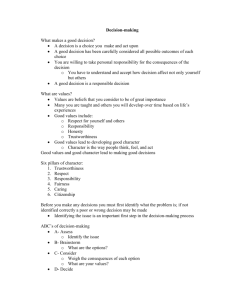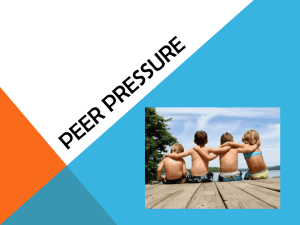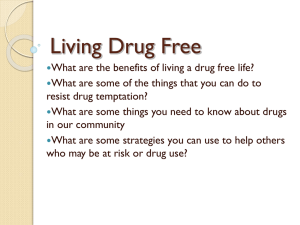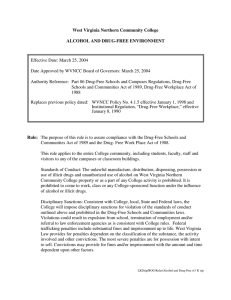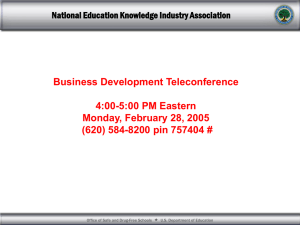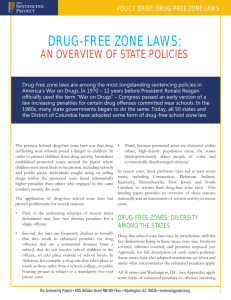Content Outline
advertisement
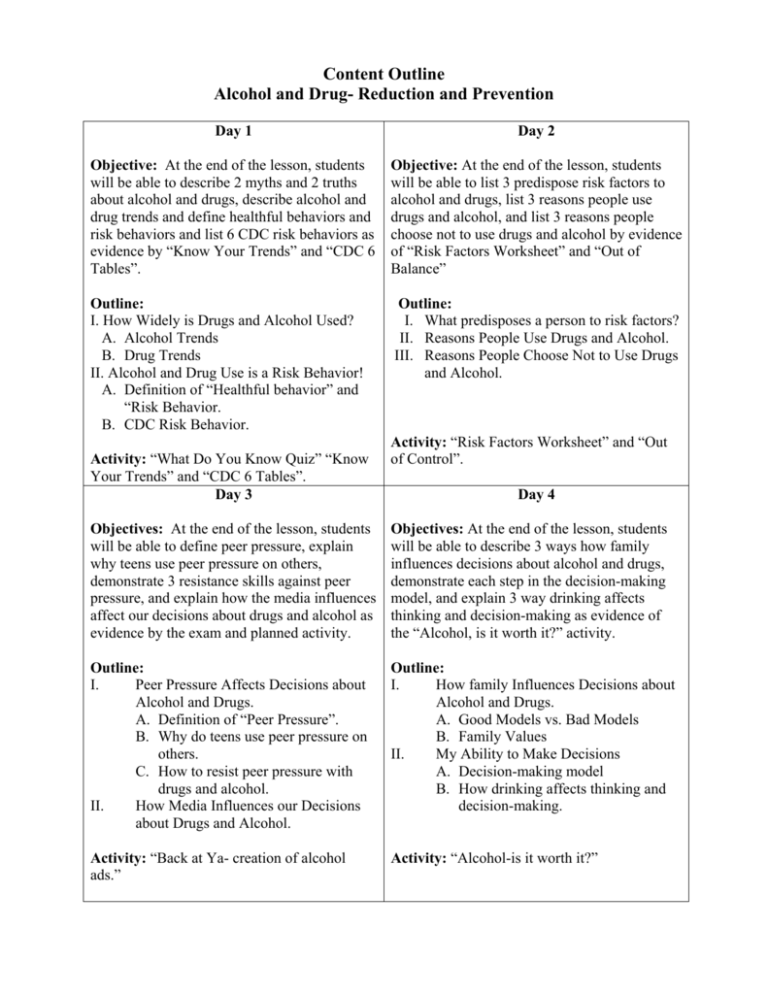
Content Outline Alcohol and Drug- Reduction and Prevention Day 1 Day 2 Objective: At the end of the lesson, students will be able to describe 2 myths and 2 truths about alcohol and drugs, describe alcohol and drug trends and define healthful behaviors and risk behaviors and list 6 CDC risk behaviors as evidence by “Know Your Trends” and “CDC 6 Tables”. Objective: At the end of the lesson, students will be able to list 3 predispose risk factors to alcohol and drugs, list 3 reasons people use drugs and alcohol, and list 3 reasons people choose not to use drugs and alcohol by evidence of “Risk Factors Worksheet” and “Out of Balance” Outline: I. How Widely is Drugs and Alcohol Used? A. Alcohol Trends B. Drug Trends II. Alcohol and Drug Use is a Risk Behavior! A. Definition of “Healthful behavior” and “Risk Behavior. B. CDC Risk Behavior. Outline: I. What predisposes a person to risk factors? II. Reasons People Use Drugs and Alcohol. III. Reasons People Choose Not to Use Drugs and Alcohol. Activity: “What Do You Know Quiz” “Know Your Trends” and “CDC 6 Tables”. Day 3 Activity: “Risk Factors Worksheet” and “Out of Control”. Day 4 Objectives: At the end of the lesson, students will be able to define peer pressure, explain why teens use peer pressure on others, demonstrate 3 resistance skills against peer pressure, and explain how the media influences affect our decisions about drugs and alcohol as evidence by the exam and planned activity. Objectives: At the end of the lesson, students will be able to describe 3 ways how family influences decisions about alcohol and drugs, demonstrate each step in the decision-making model, and explain 3 way drinking affects thinking and decision-making as evidence of the “Alcohol, is it worth it?” activity. Outline: I. Peer Pressure Affects Decisions about Alcohol and Drugs. A. Definition of “Peer Pressure”. B. Why do teens use peer pressure on others. C. How to resist peer pressure with drugs and alcohol. II. How Media Influences our Decisions about Drugs and Alcohol. Outline: I. How family Influences Decisions about Alcohol and Drugs. A. Good Models vs. Bad Models B. Family Values II. My Ability to Make Decisions A. Decision-making model B. How drinking affects thinking and decision-making. Activity: “Back at Ya- creation of alcohol ads.” Activity: “Alcohol-is it worth it?” Day 5 Day 6 Objective: At the end of the lesson, students will be able to describe consequences of drinking, and the physical effects of alcohol on the body as evidence by “webquest” activity. Objective: By the end of the lesson, students will be able to list 4 alcohol related problems and identify characteristics, causes, and consequences of alcoholism by evidence of “glaciers” and “slow leak” classroom activities. Outline: I. Alcohol and Consequences of Drinking. A. What is alcohol? B. Alcohol Absorption C. Intoxication II. Physical Effects of Alcohol. A. Short-term B. Long-term Activity: “Web Quest” Day 7 Objective: By the end of the lesson, students will be able to state 3 effects of the following drugs: marijuana, inhalants, steroids, stimulants as evidence by creating a real life senario that includes the effects of their assigned drug and the “unknown” activity. Outline: I. Drugs of Abuse and Effects A. Marijuana B. Inhalants C. Steroids D. Stimulants Outline: I. Alcohol Related Problems A. Violence B. Accidents C. Suicide D. Fetal Alcohol Syndrome (FAS) II. Alcoholism A. Characteristics B. Causes C. Consequences Activity: “Slow-leak” and “Glaciers” Day 8 Objective: By the end of the lesson, students will be able to describe 3 consequences and effects of the following drugs: sedativehypnotic, narcotics, hallucinogens, and overthe-counter drugs as evidence by “webquest” activity. Outline: I. Consequences and Effects of Drugs A. Sedative-Hypnotic B. Narcotics C. Hallucinogens D. Over-the-counter drugs Activity: “Unknown” drug activity Activity: “Web Quest” Day 9 Objective: By the end of the lesson, students will be able to explain 2 reasons why it is important to be drug-free; state 3 ways how to be a drug-free role model; describe 4 skills used to reduce/manage conflict, and role play 3 different resistance skills by evidence of “role playing” and “Right Choices” classroom activities. Outline: I. The Decision to be Drug-Free A. Why is it Important to be Drug-Free? B. How to be a Drug-Free Role Model C. Skills to Reduce/Manage Conflict D. Resistance Skills Activity: “Role Playing” and “Right Choices”. Day 10 Objective: By the end of the lesson, students will be able to identify the major regions that are a drug source for the U.S., explain economic costs of drugs, and state 3 ways to take action against Drugs and Terror by evidence of “Map Work” and “What it CostsDrugs”. Outline: I. Drugs and Terror A. Drug Sources B. Costs C. Taking Action Activity: “Map Work” and “What it CostsDrugs”.
